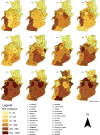Epidemiology and time series analysis of human brucellosis in Tebessa province, Algeria, from 2000 to 2020
- PMID: 36511254
- PMCID: PMC9315461
- DOI: 10.34172/jrhs.2022.79
Epidemiology and time series analysis of human brucellosis in Tebessa province, Algeria, from 2000 to 2020
Abstract
Background: Brucellosis runs rampant endemically with sporadic outbreaks in Algeria. The present study aimed to provide insights into the epidemiology of brucellosis and compare the performance of some prediction models using surveillance data from Tebessa province, Algeria.
Study design: A retrospective study.
Methods: Seasonal autoregressive integrated moving average (SARIMA), neural network autoregressive (NNAR), and hybrid SARIMA-NNAR models were developed to predict monthly brucellosis notifications. The prediction performance of these models was compared using root mean square error (RMSE), mean absolute error (MAE), and mean absolute percentage error (MAPE).
Results: Overall, 13 670 human brucellosis cases were notified in Tebessa province from 2000-2020 with a male-to-female ratio of 1.3. The most affected age group was 15-44 years (56.2%). The cases were reported throughout the year with manifest seasonality. The annual notification rate ranged from 30.9 (2013) to 246.7 (2005) per 100 000 inhabitants. The disease was not evenly distributed, rather spatial and temporal variability was observed. The SARIMA (2,1,3) (1,1,1)12, NNAR (12,1,6)12, and SARIMA (2,0,2) (1,1,0)12-NNAR (5,1,4)12 were selected as the best-fitting models. The RMSE, MAE, and MAPE of the SARIMA and SARIMA-NNAR models were by far lower than those of the NNAR model. Moreover, the SARIMA-NNNAR hybrid model achieved a slightly better prediction accuracy for 2020 than the SARIMA model.
Conclusion: As evidenced by the obtained results, both SARIMA and hybrid SARIMA-NNAR models are suitable to predict human brucellosis cases with high accuracy. Reasonable predictions, along with mapping brucellosis incidence, could be of great help to veterinary and health policymakers in the development of informed, effective, and targeted policies, as well as timely interventions.
Keywords: Human brucellosis; Neural network auto-regressive; Prediction; SARIMA model; Tebessa province; model.
References
-
- Corbel MJ. Brucellosis in Humans and Animals. WHO; 2016. Available from: https://apps.who.int/iris/handle/10665/43597. Accessed January 10, 2022.
MeSH terms
LinkOut - more resources
Full Text Sources
Research Materials



